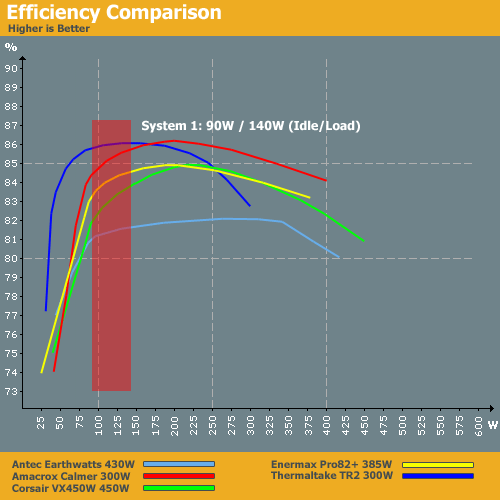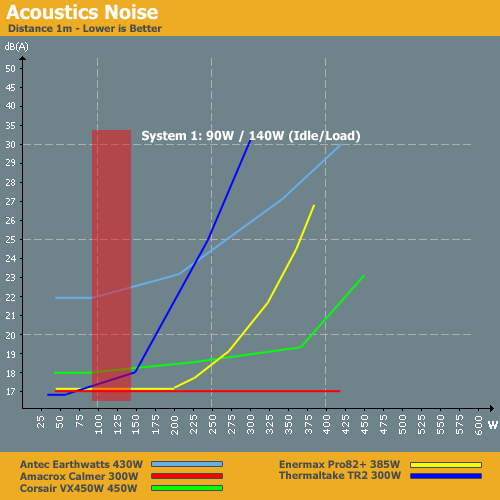Debunking Power Supply Myths
by Christoph Katzer on September 22, 2008 3:00 AM EST- Posted in
- Cases/Cooling/PSUs
Making Compromises
What we have learned from the preceding PSU example? A higher rated power supply will run much quieter if it runs at less than 50% of its rated output, but you don't want the rating to be too high or else efficiency will drop. Now we come to the more complicated part of choosing the right power supply for a new system. You need to make compromises between achieving optimal efficiency and maintaining a quiet working environment. If that is your goal, our high-end sample system is a perfect candidate for a 900W power supply like the Cooler Master UCP 900W. Efficiency is very good throughout the operating range and noise levels will be far lower than the ambient noise from the rest of the system. What we want to do now is go through the three sample systems and select an appropriate power supply.
Our entry-level system has very low power consumption, and unfortunately most power supply manufacturers completely ignore this market segment. Our goal today is to focus on quality power supplies that are readily available worldwide, and most manufacturers start with 500W models and go up from there. That limits our choices, but there are still a few options.
We can only be sure about efficiency if we've tested a power supply, so we will confine ourselves to such units. (Note that we have not necessarily published reviews on all of these power supplies, but we have tested them.) Our entry-level system uses an ATI Radeon HD 3650 graphics card, which means we don't need a PEG connector; that makes our choices a little easier. We'll focus on the following offerings:
- Thermaltake TR2 QFan (300W) actively cooled
- Enermax Pro82+ (385W) actively cooled
- Amacrox Calmer 560 (300W) passively cooled
- Corsair VX450W (450W) actively cooled
- Antec Earthwatts (430W) actively cooled

In the range of 90W to 140W, it's little surprise that the best efficiency is achieved by the two power supplies with the lowest rating (300W). The Thermaltake TR2 QFan places first in our results, and second place goes to the Amacrox Calmer 560. The Enermax takes third place, Corsair is in fourth, and Antec ranks at the bottom of these five options. If it were possible to find a 250W power supply with similar performance at a lower price, that would be even better, but it's just not possible these days. That takes care of efficiency, but let's look at noise levels.

In the same range of 90W to 140W, the Amacrox Calmer 560 and Enermax Pro82+ are the best performers, with the overall crown going to Amacrox, since the Calmer 560 is passively cooled. The Thermaltake TR2 QFan and Corsair VS450W aren't too far behind, at only 18 dB(A) max, while Antec brings up the rear again.
Looking at the above two charts, the Thermaltake TR2 QFan is a perfect candidate for our entry-level system. However, if you instead prefer silence, we would go ahead and pick up the Amacrox Calmer 560. The HD 3650 is also available with passive cooling, so you will never have to complain about computer noise. In fact, I have that exact setup and use it daily as my system for web surfing and writing articles.
As the graphs show, there's still plenty of performance available, so we could even make a few system upgrades down the road. In truth, we could run this sort of system with a 200W power supply, but there are no quality PSUs available in that range. The desire for quality is what led us to select the Amacrox, Thermaltake, Enermax, Corsair, and Antec offerings, as they all provide excellent voltage regulation and overall quality.










98 Comments
View All Comments
LTG - Monday, September 22, 2008 - link
You can't just look at the TDP's, that's the problem.When you overclock the power demands can increase in a very non-linear way.
So for example I can't plan for one of the most popular 280 cards like the EVGA FTW 280 GTX. It's 11% core over clocked, what does that mean at the outlet? No good way to guess.
Same for a 3.6Ghz QC CPU - this is a very common overclock, yet there is no direct way to know it's power requirements.
I'm just saying this is not esoteric information, this would be data people really could use and can't get from the manufacturer.
xaris106 - Friday, November 7, 2008 - link
But you can. All you need is stock power consumption at load(Pstock), stock voltage(Vstock) and stock frequency(Fstock) The oc power is then:Poc = Pstock * (Foc/Fstock) * (Voc/Vstock)^2
nubie - Monday, September 22, 2008 - link
Unless they edited this, you are operating on a false assumption.(Unfortunately, our power supply testing labs didn't have the latest GPUs available for testing.)
A power supply testing lab doesn't need to have every component on hand because it uses a test bench to load the supplies.
Great article, way to dispel myths, I guess since I only plan to overclock with a single video card and one or two hard drives my PCPower Silencer 470 will be enough power for many years to come (which is what I hoped when I bought it, the only downside is the single 6-pin for the video card, when it can clearly handle much more.)
JarredWalton - Monday, September 22, 2008 - link
Just for the curious, AnandTech staff is scattered far and wide around the globe (well, at least the US and Europe). I'm west coast, Wes is east coast, Anand and Derek are in NC, Gary is in TX, and we have Johan and Liz in Belgium with Christoph in France. (That's not everyone, but you get the point.) Since we tend to focus on our own areas of testing, Derek and Anand have the most CPU/GPU hardware, I have laptops and displays, Gary has motherboards, etc. I can definitely say that Christoph isn't the only one without 48x0 and GTX 2x0 hardware. [Pardon me while I go cry in a corner now....]hyvonen - Wednesday, June 3, 2009 - link
Oh, so in order to get this power draw info on more components, I should beg Anand? :)LTG - Monday, September 22, 2008 - link
Totally understood, many companies now days are distributed and can't have every physical resource available to every person.However I would volunteer to send Christof a new 280 GTX to test if he decides it's worth it.
Serious - Just please send it back whenever finished :). And I waive all claims if it is accidentally fried by that fancy Chroma thingy.
ineedaname - Tuesday, November 2, 2010 - link
This article is well written and tried to put real life numbers and situations to the test on PSUs.However i felt that they should mention one other thing for people who are novice to computers. They should mention that just because a PSU is rated for 500w it doesn't necessarily mean that it will do the job even if your computer will only suck about 150w max. Because a 500w psu that comes along with a $50 case just won't do the job. Not because of the wattage rating but because they use crappy parts and workmanship; it'll just die in 3 months when the warranty is over.
gsuburban - Saturday, November 11, 2017 - link
This article was written in 2008. It would be great if it were updated with the more modern CPU's and Motherboards/Chipsets. Many experts suggest most systems don't need more than 400 watts as long as the PSU is a quality make.This would be a great addition with more modern hardware especially now that we have SSD's and M.2 hard drives.